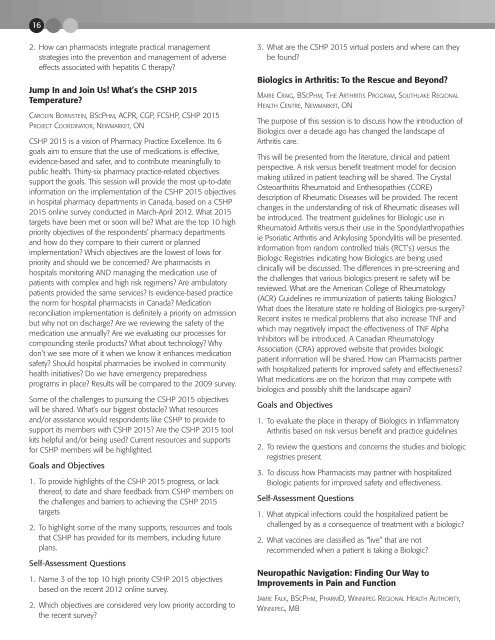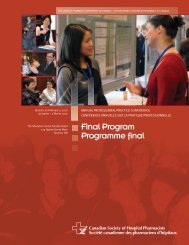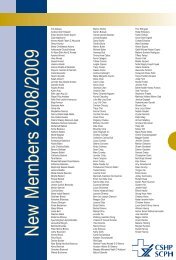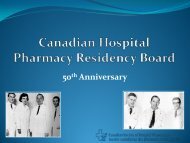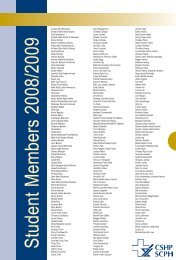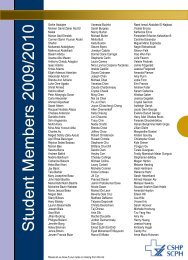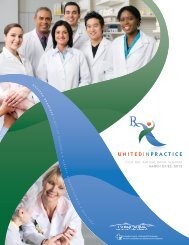Final Program - Canadian Society of Hospital Pharmacists
Final Program - Canadian Society of Hospital Pharmacists
Final Program - Canadian Society of Hospital Pharmacists
Create successful ePaper yourself
Turn your PDF publications into a flip-book with our unique Google optimized e-Paper software.
16<br />
2. How can pharmacists integrate practical management<br />
strategies into the prevention and management <strong>of</strong> adverse<br />
effects associated with hepatitis C therapy?<br />
Jump In and Join Us! What’s the CSHP 2015<br />
Temperature?<br />
CAROLYN BORNSTEIN, BSCPHM, ACPR, CGP, FCSHP, CSHP 2015<br />
PROJECT COORDINATOR, NEWMARKET, ON<br />
CSHP 2015 is a vision <strong>of</strong> Pharmacy Practice Excellence. Its 6<br />
goals aim to ensure that the use <strong>of</strong> medications is effective,<br />
evidence-based and safer, and to contribute meaningfully to<br />
public health. Thirty-six pharmacy practice-related objectives<br />
support the goals. This session will provide the most up-to-date<br />
information on the implementation <strong>of</strong> the CSHP 2015 objectives<br />
in hospital pharmacy departments in Canada, based on a CSHP<br />
2015 online survey conducted in March-April 2012. What 2015<br />
targets have been met or soon will be? What are the top 10 high<br />
priority objectives <strong>of</strong> the respondents’ pharmacy departments<br />
and how do they compare to their current or planned<br />
implementation? Which objectives are the lowest <strong>of</strong> lows for<br />
priority and should we be concerned? Are pharmacists in<br />
hospitals monitoring AND managing the medication use <strong>of</strong><br />
patients with complex and high risk regimens? Are ambulatory<br />
patients provided the same services? Is evidence-based practice<br />
the norm for hospital pharmacists in Canada? Medication<br />
reconciliation implementation is definitely a priority on admission<br />
but why not on discharge? Are we reviewing the safety <strong>of</strong> the<br />
medication use annually? Are we evaluating our processes for<br />
compounding sterile products? What about technology? Why<br />
don’t we see more <strong>of</strong> it when we know it enhances medication<br />
safety? Should hospital pharmacies be involved in community<br />
health initiatives? Do we have emergency preparedness<br />
programs in place? Results will be compared to the 2009 survey.<br />
Some <strong>of</strong> the challenges to pursuing the CSHP 2015 objectives<br />
will be shared. What’s our biggest obstacle? What resources<br />
and/or assistance would respondents like CSHP to provide to<br />
support its members with CSHP 2015? Are the CSHP 2015 tool<br />
kits helpful and/or being used? Current resources and supports<br />
for CSHP members will be highlighted.<br />
Goals and Objectives<br />
1. To provide highlights <strong>of</strong> the CSHP 2015 progress, or lack<br />
there<strong>of</strong>, to date and share feedback from CSHP members on<br />
the challenges and barriers to achieving the CSHP 2015<br />
targets<br />
2. To highlight some <strong>of</strong> the many supports, resources and tools<br />
that CSHP has provided for its members, including future<br />
plans.<br />
Self-Assessment Questions<br />
1. Name 3 <strong>of</strong> the top 10 high priority CSHP 2015 objectives<br />
based on the recent 2012 online survey.<br />
2. Which objectives are considered very low priority according to<br />
the recent survey?<br />
3. What are the CSHP 2015 virtual posters and where can they<br />
be found?<br />
Biologics in Arthritis: To the Rescue and Beyond?<br />
MARIE CRAIG, BSCPHM, THE ARTHRITIS PROGRAM, SOUTHLAKE REGIONAL<br />
HEALTH CENTRE, NEWMARKET, ON<br />
The purpose <strong>of</strong> this session is to discuss how the introduction <strong>of</strong><br />
Biologics over a decade ago has changed the landscape <strong>of</strong><br />
Arthritis care.<br />
This will be presented from the literature, clinical and patient<br />
perspective. A risk versus benefit treatment model for decision<br />
making utilized in patient teaching will be shared. The Crystal<br />
Osteoarthritis Rheumatoid and Enthesopathies (CORE)<br />
description <strong>of</strong> Rheumatic Diseases will be provided. The recent<br />
changes in the understanding <strong>of</strong> risk <strong>of</strong> Rheumatic diseases will<br />
be introduced. The treatment guidelines for Biologic use in<br />
Rheumatoid Arthritis versus their use in the Spondylarthropathies<br />
ie Psoriatic Arthritis and Ankylosing Spondylitis will be presented.<br />
Information from random controlled trials (RCT’s) versus the<br />
Biologic Registries indicating how Biologics are being used<br />
clinically will be discussed. The differences in pre-screening and<br />
the challenges that various biologics present re safety will be<br />
reviewed. What are the American College <strong>of</strong> Rheumatology<br />
(ACR) Guidelines re immunization <strong>of</strong> patients taking Biologics?<br />
What does the literature state re holding <strong>of</strong> Biologics pre-surgery?<br />
Recent insites re medical problems that also increase TNF and<br />
which may negatively impact the effectiveness <strong>of</strong> TNF Alpha<br />
Inhibitors will be introduced. A <strong>Canadian</strong> Rheumatology<br />
Association (CRA) approved website that provides biologic<br />
patient information will be shared. How can <strong>Pharmacists</strong> partner<br />
with hospitalized patients for improved safety and effectiveness?<br />
What medications are on the horizon that may compete with<br />
biologics and possibly shift the landscape again?<br />
Goals and Objectives<br />
1. To evaluate the place in therapy <strong>of</strong> Biologics in Inflammatory<br />
Arthritis based on risk versus benefit and practice guidelines<br />
2. To review the questions and concerns the studies and biologic<br />
registries present<br />
3. To discuss how <strong>Pharmacists</strong> may partner with hospitalized<br />
Biologic patients for improved safety and effectiveness.<br />
Self-Assessment Questions<br />
1. What atypical infections could the hospitalized patient be<br />
challenged by as a consequence <strong>of</strong> treatment with a biologic?<br />
2. What vaccines are classified as “live” that are not<br />
recommended when a patient is taking a Biologic?<br />
Neuropathic Navigation: Finding Our Way to<br />
Improvements in Pain and Function<br />
JAMIE FALK, BSCPHM, PHARMD, WINNIPEG REGIONAL HEALTH AUTHORITY,<br />
WINNIPEG, MB


